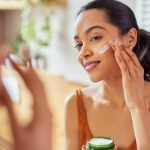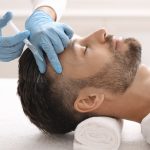In the world of skincare, you may have heard the terms AHAs and BHAs. These are two powerful exfoliating ingredients that can transform your skin. While both offer benefits, they work in distinct ways, so it is helpful to understand how they work. Our dermatology experts explain AHAs vs. BHAs.
Understanding AHAs vs. BHAs
Alpha hydroxy acids (AHAs) and beta hydroxy acids (BHAs) are types of chemical exfoliants that remove dead skin cells. They are naturally occurring acids found in the bark of a willow tree, sugar cane and some citrus fruits. Many skincare products, like cleansers and serums, have AHAs and BHAs.
AHA and BHA products are also different from a chemical peel treatment you may get in a dermatologist’s office. The concentration of acids is lower for at-home use than a prescription-strength formula.
To prevent irritation, you should use a physical exfoliant no more often than weekly. You can use a BHA or AHA more frequently as your skin acclimates to the product.
Products with AHAs and BHAs include cleansers, serums, masks and facial retexturing pads. You will see results more slowly with chemical exfoliants, but they have longer-lasting benefits.
AHAs
AHAs are water-soluble acids that primarily work on the top layer of the skin. They are ideal for treating concerns such as fine lines, uneven texture and sun damage. AHAs work by dissolving the bonds between dead skin cells to promote shedding for a brighter, smoother complexion.
Common AHAs include glycolic acid and lactic acid. Glycolic acid can easily penetrate the skin, which helps prevent new breakouts and minimizes pores.
Lactic acid is a chemical known for promoting hydration in the skin. They can increase the levels of naturally occurring hyaluronic acid within the skin to keep your skin plump and smooth.
AHAs are a good option for people who want to improve the appearance of fine lines, wrinkles and sun damage. If you have dry skin, you may prefer AHAs over BHAs, which break up oil.
People with sensitive skin may have a higher risk of irritation because AHAs tend to be stronger than BHAs.
BHAs
BHAs are chemical exfoliants that penetrate deep into the pores. They are particularly effective for people with oily and acne-prone skin. Salicylic acid is the most common BHA. It can penetrate the pores, where excess oil and debris often accumulate.
Using BHAs in your skincare routine can help reduce blackheads and whiteheads. If you suffer from an oily scalp, using a shampoo with salicylic acid can help. It cuts through the oil and buildup.
BHAs are oil-soluble, so they can penetrate through sebum, the oily substance that keeps your skin hydrated. Some people have too much sebum, which can lead to acne, oily skin and, in some cases, seborrheic dermatitis.
BHAs also possess anti-inflammatory and anti-bacterial properties, which can help calm the redness and inflammation associated with breakouts.
Choosing AHAs vs. BHAs based on your skin type
Using AHAs
AHAs are versatile and suitable for most skin types, especially those with concerns related to texture, pigmentation and signs of aging. If you want to tackle fine lines, uneven skin tone or sun damage, AHAs like glycolic or lactic acid can help.
If you have sensitive skin, you should be mindful and choose a milder formulation to avoid irritation.
Using BHAs
If you struggle with acne, blackheads or oily skin, BHAs are a great addition to your skincare routine. BHAs are oil-soluble, so they can penetrate deeply into pores to dissolve sebum and debris and prevent breakouts.
People with sensitive skin should remember that BHAs can be drying or irritating. Start with a lower concentration and gradually increase frequency to reduce potential side effects.
Combination approach
In some cases, a combination of both AHA and BHA products might be the key to achieving optimal skin health. This approach can address multiple concerns simultaneously. For example, if you have acne and dark spots, you can use BHAs for breakouts and AHAs for hyperpigmentation.
However, combining these acids requires careful consideration of concentrations and application schedules to prevent over-exfoliation. Check with your dermatologist if you have questions about which product to use or if you want to use a combination.
When using AHAs or BHAs, always finish off your daily routine with sunscreen. The acids make the skin more sensitive to sunlight, so you will need to protect your skin.
Results and patience
Remember that visible results may take time when adding AHAs or BHAs into your skincare routine. Skin turnover occurs in cycles, so patience is key. Initial improvements might be subtle, but consistent use can lead to improvements over time.
With BHAs, you may notice fewer acne breakouts and blackheads and a more refined skin texture. AHAs can gradually reveal smoother, brighter skin with reduced fine lines and improved overall radiance.
Skincare consult at Columbia Skin Clinic
Still have questions about AHAs vs. BHAs? If you want to introduce new skincare products into your routine, our staff can provide personalized advice tailored to your needs. Make an appointment with one of our board-certified dermatologists to achieve your skin goals.






